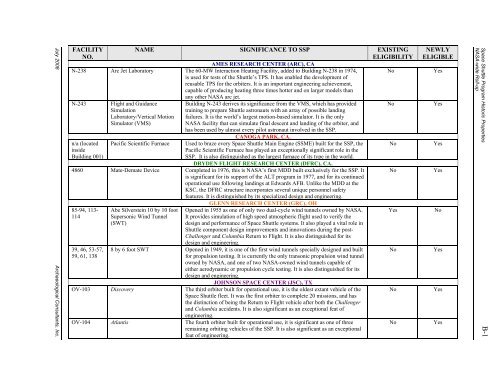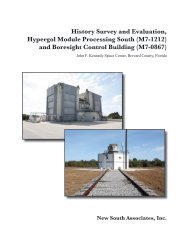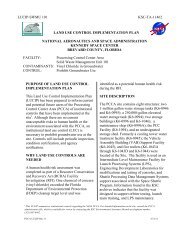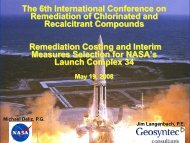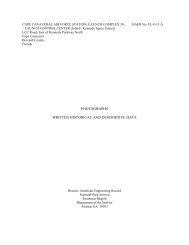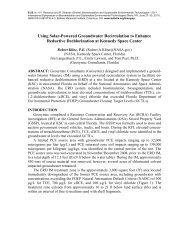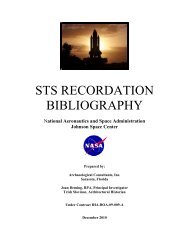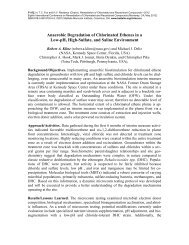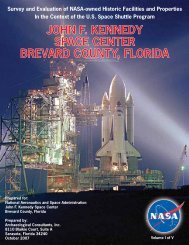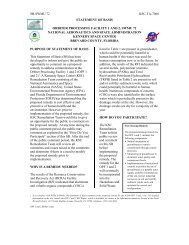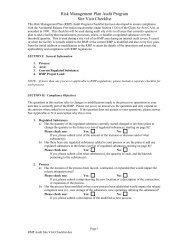Part II - Environmental Program at KSC - NASA
Part II - Environmental Program at KSC - NASA
Part II - Environmental Program at KSC - NASA
Create successful ePaper yourself
Turn your PDF publications into a flip-book with our unique Google optimized e-Paper software.
July 2008 Archaeological Consultants, Inc.FACILITYNO.NAME SIGNIFICANCE TO SSP EXISTINGELIGIBILITYAMES RESEARCH CENTER (ARC), CAN-238 Arc Jet Labor<strong>at</strong>ory The 60-MW Interaction He<strong>at</strong>ing Facility, added to Building N-238 in 1974,Nois used for tests of the Shuttle’s TPS. It has enabled the development ofreusable TPS for the orbiters. It is an important engineering achievement,capable of producing he<strong>at</strong>ing three times hotter and on larger models thanN-243 Flight and GuidanceSimul<strong>at</strong>ionLabor<strong>at</strong>ory/Vertical MotionSimul<strong>at</strong>or (VMS)n/a (loc<strong>at</strong>edinsideBuilding 001)Pacific Scientific Furnaceany other <strong>NASA</strong> arc jet.Building N-243 derives its significance from the VMS, which has providedtraining to prepare Shuttle astronauts with an array of possible landingfailures. It is the world’s largest motion-based simul<strong>at</strong>or. It is the only<strong>NASA</strong> facility th<strong>at</strong> can simul<strong>at</strong>e final descent and landing of the orbiter, andhas been used by almost every pilot astronaut involved in the SSP.CANOGA PARK, CA.Used to braze every Space Shuttle Main Engine (SSME) built for the SSP, thePacific Scientific Furnace has played an exceptionally significant role in theSSP. It is also distinguished as the largest furnace of its type in the world.DRYDEN FLIGHT RESEARCH CENTER (DFRC), CA.4860 M<strong>at</strong>e-Dem<strong>at</strong>e Device Completed in 1976, this is <strong>NASA</strong>’s first MDD built exclusively for the SSP. Itis significant for its support of the ALT program in 1977, and for its continuedoper<strong>at</strong>ional use following landings <strong>at</strong> Edwards AFB. Unlike the MDD <strong>at</strong> the<strong>KSC</strong>, the DFRC structure incorpor<strong>at</strong>es several unique personnel safetyfe<strong>at</strong>ures. It is distinguished by its specialized design and engineering.85-94, 113-11439, 46, 53-57,59, 61, 138Abe Silverstein 10 by 10 footSupersonic Wind Tunnel(SWT)GLENN RESEARCH CENTER (GRC), OHOpened in 1955 as one of only two dual-cycle wind tunnels owned by <strong>NASA</strong>.It provides simul<strong>at</strong>ion of high speed <strong>at</strong>mospheric flight used to verify thedesign and performance of Space Shuttle systems. It also played a vital role inShuttle component design improvements and innov<strong>at</strong>ions during the post-Challenger and Columbia Return to Flight. It is also distinguished for itsdesign and engineering.8 by 6 foot SWT Opened in 1949, it is one of the first wind tunnels specially designed and builtfor propulsion testing. It is currently the only transonic propulsion wind tunnelowned by <strong>NASA</strong>, and one of two <strong>NASA</strong>-owned wind tunnels capable ofeither aerodynamic or propulsion cycle testing. It is also distinguished for itsdesign and engineering.JOHNSON SPACE CENTER (JSC), TXOV-103 Discovery The third orbiter built for oper<strong>at</strong>ional use, it is the oldest extant vehicle of theSpace Shuttle fleet. It was the first orbiter to complete 20 missions, and hasthe distinction of being the Return to Flight vehicle after both the Challengerand Columbia accidents. It is also significant as an exceptional fe<strong>at</strong> ofengineering.OV-104 Atlantis The fourth orbiter built for oper<strong>at</strong>ional use, it is significant as one of threeremaining orbiting vehicles of the SSP. It is also significant as an exceptionalfe<strong>at</strong> of engineering.NoNoNoYesNoNoNoNEWLYELIGIBLEYesYesYesYesNoYesYesYesSpace Shuttle <strong>Program</strong> Historic Properties<strong>NASA</strong>-wide Roll-upB-1


